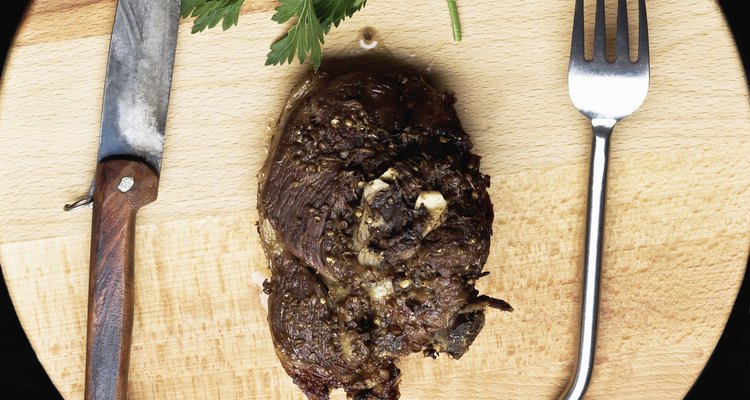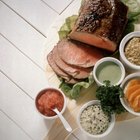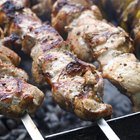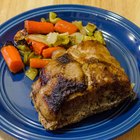
ladi59/iStock/Getty Images
Lamb shoulder fillet has the aesthetics of lamb tenderloin, but is best cooked with moist heat instead of dry heat. Shoulder fillet gets it name from its resemblance to the tenderloin, but it actually comes from the neck region, so it has a lot more connective tissue. You can cook shoulder fillet if you cut it into escalopes -- thinly sliced cuts of meat pounded with a tenderizing mallet -- and saute it quickly on the stove. If you want to roast shoulder fillet, treat it like a braise and cook it over low heat on the stovetop.
Escalopes
Slice the lamb shoulder fillets crosswise into 1/4- to 1/2-inch-thick slices. Working with 1 piece at a time, cover each slice with plastic wrap and pound it with the knobby side of a meat mallet several times without tearing holes in it.
Marinate the escalopes in an oil-acid marinade for 30 minutes to 1 hour in the refrigerator before cooking, if desired. A couple tablespoons of olive oil and food acid, such as soy sauce or lemon juice, along with a few spices and herbs to taste are all you need.
Season the escalopes to taste and set aside. Heat a tablespoon or so of olive oil in a saute pan over medium-high on the stove.
Dredge the escalopes in flour or breadcrumbs on both sides and place them in the hot oil. Saute lamb escalopes for 2 to 3 minutes on each side and serve.
Whole Shoulder Fillet
Marinate whole shoulder fillet for 24 hours in an oil-acid marinade or season it with kosher salt heavily 24 hours before cooking it. Use half a cup of olive oil per tablespoon of food acid, along with alliums, such as garlic and shallots, and herbs, kosher salt and spices to taste.
Set the shoulder fillet out about 1 hour before you want to cook it and let it reach room temperature. Wipe the excess marinade or salt from the fillet.
Heat a couple tablespoons of olive oil in a heavy-bottomed pan over medium heat on the stove. Dutch ovens and cast-iron skillets work best, but you can use just about pot as long as its deep and has straight sides.
Sear the shoulder fillet on all sides until golden brown, using tongs to turn and hold it to the pan as needed, about 5 minutes. Transfer the shoulder fillet to a plate and set aside.
Saute mirepoix and pungents in the oil and rendered fat until golden brown. Use ingredients you want to flavor the fillet with. In addition to mirepoix, or carrots, onions and celery, chopped pungents like garlic and ginger work well with neck meat.
Deglaze the pan with a cup of stock or acidic red wine and add the lamb fillet. Add enough stock and wine to cover the fillet by half. Use at least 1/2 cup of dry, acidic red wine for the cooking liquid -- its acid works with the heat to break down connective tissue.
Lower the heat so the liquid bubbles occasionally but doesn't simmer; about 180 degrees Fahrenheit if you want to use an instant-read thermometer to check it.
Cover the pan with a lid or a couple layers of foil. Braise the shoulder fillet until tender, or about 2 to 3 hours. Fully tender shoulder fillets tear apart effortlessly with a fork.
Transfer the lamb fillet to a plate after 2 to 3 hours of braising. Strain the cooking liquid through a mesh strainer and return it to the pot. Simmer the cooking liquid until it reduces to a glaze.
Slice the lamb across the grain and coat it in the sauce. Serve immediately.
Related Articles
How to Cook a Lamb Square Cut Shoulder
The Best Way to Cook Bison Steak

How to Cook an Elk Shoulder

How to Cook Moonfish

How to Cook a Bone-in Leg of Lamb
How to Cook a Goat Shoulder
How to Cook Buffalo Fillet

How to Cook Axis Deer Steaks

How to Cook Veal Sirloin

How to Cook a Pork Loin Fillet

How to Cook Alligator Steak
What Is the Best Way to Cook Swordfish?

Arm Roast Vs. Rump Roast

How to Cook a Flat-Cut Rump Roast

How to Cook a Tender Lamb Breast

How to Cook a Beef Topside Roast
Cooking Guide for Semi-Boneless Beef ...

How to Cook Pork Roast in an Oven

How to Cook Beef Tenderloin on a ...

How to Cook Boned Rolled Shoulder of ...
Writer Bio
A.J. Andrews' work has appeared in Food and Wine, Fricote and "BBC Good Food." He lives in Europe where he bakes with wild yeast, milks goats for cheese and prepares for the Court of Master Sommeliers level II exam. Andrews received formal training at Le Cordon Bleu.
Photo Credits
ladi59/iStock/Getty Images